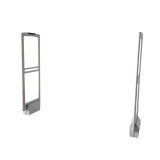In today’s fast-paced world of cattle farming, efficiency and productivity are key factors for success. One technology that has revolutionized the industry is RFID tags for cattle. When attached to the ears or other parts of the animal, these small electronic devices provide a means of tracking and managing livestock more effectively. This article will explore the latest trends in wholesale RFID tags for cattle and how they can enhance herding efficiency on farms.
The benefits of RFID tags for cattle
- Improved herd management: RFID tags allow farmers to identify and track individual animals within their herds easily. This enables accurate record-keeping and helps monitor each cow or bull’s health, breeding, and feeding schedules.
- Time and labor savings: With RFID tags, manual counting and sorting of cattle becomes a thing of the past. Farmers can quickly scan the tags using handheld or fixed RFID readers, reducing the time and effort required for inventory management and monitoring tasks.
- Traceability and food safety: RFID tags provide a reliable and efficient means of traceability in the supply chain. From farm to fork, the movement of cattle can be accurately recorded, ensuring food safety standards are met and enabling quick responses in the event of a disease outbreak.
- Reduced theft and loss: RFID tags make identifying and recovering stolen or lost cattle easier. The unique identification numbers stored in the tags can be registered in databases, which authorities can access in case of theft or accidental loss.
- Data-driven decision-making: By capturing real-time data through RFID tags, farmers can gain valuable insights into the behavior, health, and performance of their cattle. This information can help inform breeding, feeding, and overall herd management decisions.

Latest trends in wholesale RFID tags for cattle
1. Advanced tracking and monitoring
The latest RFID tags for cattle have advanced tracking and monitoring capabilities. These tags utilize GPS technology to provide real-time location information about the animals. This allows farmers to understand better their livestock’s grazing patterns, movement, and behavior. By tracking the animals’ movements, farmers can also ensure they stay within designated areas and prevent potential accidents or straying.
2. Health monitoring and alerts
Wholesale RFID tags for cattle now include sensors that can monitor the health and well-being of the animals. These sensors can measure parameters such as body temperature and heart rate and even detect unusual behavior. Suppose abnormal readings or behavior patterns are detected. In that case, immediate alerts can be sent to the farmers or herd managers, allowing them to intervene quickly and prevent potential health issues or diseases from spreading.
3. Integration with livestock management systems
RFID tags are designed to integrate seamlessly with livestock management systems to streamline livestock management management. These systems can collect and analyze data from the tags, providing valuable insights into the overall health and performance of the cattle. Farmers can access this information through user-friendly interfaces, allowing them to make data-driven decisions regarding breeding, feeding, and overall herd management.
4. Automated feeding systems
With the help of RFID tags, automated feeding systems can be implemented on cattle farms. The tags can be programmed to control feed dispensers, ensuring that each animal receives the optimal amount of food based on their needs. This improves the efficiency of feeding operations and helps prevent overfeeding or underfeeding, leading to better overall health and productivity of the livestock.
5. Enhanced security features
Wholesale RFID tags for cattle now have enhanced security features to protect against tampering or unauthorized access. These tags can be encrypted, making it difficult for potential thieves or unauthorized individuals to clone or manipulate them. Furthermore, the tags can be programmed to send alerts if they are removed or tampered with, providing an additional layer of security for the animals.
Conclusion
The latest trends in wholesale RFID tags for cattle are revolutionizing how farmers manage their livestock. With advanced tracking and monitoring capabilities, health monitoring and alerts, integration with livestock management systems, automated feeding systems, and enhanced security features, RFID tags offer a wide range of benefits for cattle farms.
By embracing this technology, farmers can improve efficiency, productivity, and overall herd management, leading to better business outcomes. So, if you’re in the cattle farming industry, it’s time to consider incorporating wholesale RFID tags into your operations and take advantage of these latest trends.
FAQs
1. What is the purpose of the RFID in cattle?
RFID in cattle serves the purpose of livestock identification and tracking. RFID tags are commonly used in the agricultural industry to identify and monitor individual cattle uniquely. Each RFID tag contains a unique identifier that can be read by RFID readers, allowing farmers to track each animal’s movement, health, and other relevant information. This technology streamlines inventory management, disease control, and breeding programs. RFID in cattle helps improve overall herd management, enhances traceability for food safety, and contributes to efficient and sustainable agricultural practices.
2. How can RFID technology be used to track an animal?
RFID technology is used to track animals by attaching RFID tags to them. The process involves:
- Tagging: An RFID tag is attached to the animal. The tag contains a unique identifier and can be either passive (powered by the RFID reader’s signal) or active (with its power source).
- Readers: RFID readers are strategically placed in areas where tracking is desired, such as feeding stations or entry/exit points. These readers send signals that power passive tags or receive signals from active tags.
- Data collection: When the RFID tag enters the read range of a reader, it transmits its unique identifier. The reader captures this data, associating it with the specific animal.
- Database integration: The collected data is often integrated into a database, allowing for centralized and organized information about each tracked animal.
This system enables farmers or ranchers to monitor animal movements, track health records, manage inventory, and enhance farm efficiency.
3. Where do you put a cattle tag?
Cattle tags, including RFID tags, are typically placed in the ear of the animal. The ear is a common and practical location for tagging because:
- Visibility: The ear is easily visible, allowing for quick and convenient identification.
- Minimal discomfort: Placing the tag in the ear minimizes discomfort for the animal compared to other locations.
- Ease of reading: RFID readers can quickly scan tags in the ear, ensuring efficient and accurate data capture.
There are different types of cattle tags, including visual ear tags and electronic RFID tags. RFID tags, in particular, enable automated tracking and data collection, contributing to effective livestock management in agriculture and ensuring traceability throughout the supply chain.
4. What size tag for cattle?
Cattle tags come in various sizes, and the appropriate size depends on the type of tag and the specific needs of the livestock operation. For RFID tags commonly used in cattle, particularly those placed in the ear, sizes often range from 1.5 inches to 3 inches in length.
- Standard RFID ear tags: These are often around 2 inches long and are designed to be easily visible and readable by RFID readers.
- Button-style RFID tags: These can be as small as 1.5 inches. They are typically used for electronic identification and may be embedded in the ear or attached to a visual ear tag.
The choice of tag size may also depend on regulations, the comfort of the animal, and the readability required for efficient tracking and management. Always check local regulations and consult with suppliers to determine the most suitable size for your specific use case.


































